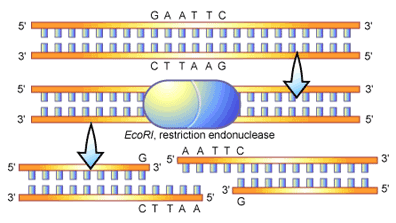Gene cloning
Say we are interested in the gene for insulin. Sure, we could take it straight from people, but remember humans are eukaryotes and eukaryotes have non-coding sequences within their genes called introns. The mRNA following splicing, on the other hand, has no introns! How can we make DNA from mRNA?
Take this arbitrary bit of mRNA: UCCAUGCCAUUUGGG
If we had an enzyme which could reverse the transcription back into DNA, this time intron-free, that would be great. We do – it’s called reverse transcriptase and it produces DNA. This special case of DNA is called complementary DNA – cDNA.
cDNA via reverse transcriptase: AGGTACGGTAAACCC (remember that DNA unlike mRNA is double-stranded; not shown for simplicity)
If we wanted the portion after the second G above, is there a way we could cut the DNA? It appears so. Some microorganisms have actually evolved enzymes whose job it is to invade a host and chop its DNA up at specific sequences. These enzymes are called restriction endonucleases. Each has its own short sequence which it recognises. There is a restriction endonuclease called CviQI which has the recognition site GTAC and cuts between G and T. That fits our bill!
The other DNA strand will also have a GTAC site read in the opposite direction. Notice that the complementary sequence of GTAC backwards (starting from the C) is… GTAC! This is called a palindrome and all restriction endonucleases will have one simply by the virtue of DNA bases being complementary.

DNA samples can be amplified by PCR to make more of it, before further processing in experiments or applications. Larger fragments of DNA can be amplified directly in bacteria, as they grow quickly and are easy to handle.
In vivo (inside a living organism) gene cloning involves stimulating bacteria to take up target DNA by inserting it in a circular bit of DNA they normally carry beside their “main” DNA, called a plasmid...

